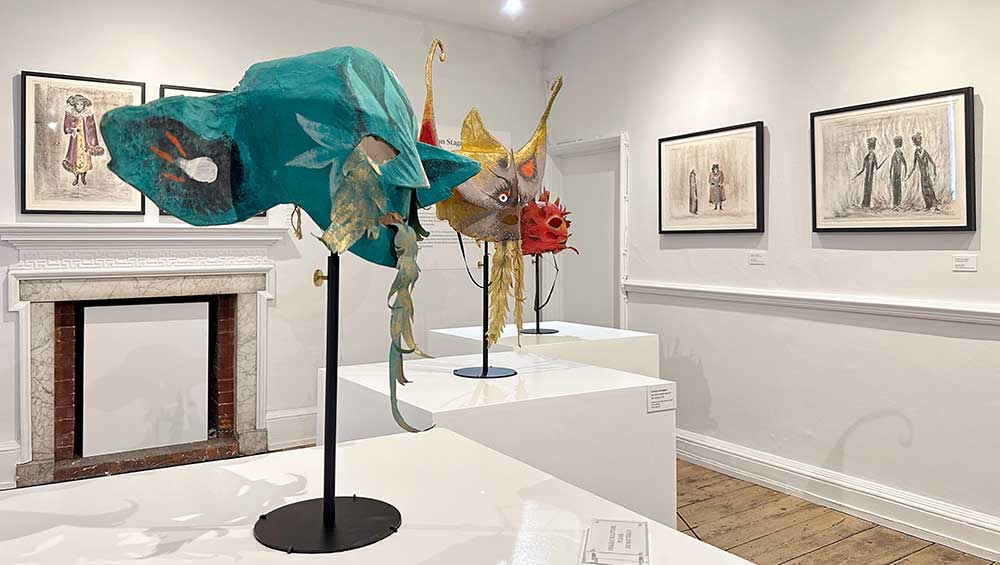
Leonora Carrington: Rebel Visionary, installation view, Newlands House Gallery, 12 July – 26 October 2024. Image courtesy Newlands House Gallery.
Newlands House Gallery, Petworth, Sussex
12 July – 26 October 2024
by ANNA McNAY
A decade ago, Leonora Carrington was not a known name in the UK. That is until her cousin, the journalist Joanna Moorhead, brought her under the spotlight with her up-close-and-personal biography, published in 2017, detailing Carrington’s amazing story of elopement, being at the epicentre of the surrealist group in Paris, hiding from the Nazis in southern France, incarceration in a Spanish asylum, and daring escape to – and new life in – Mexico. All at once, Carrington, who had died in 2011, aged 94, an eccentric English artist in her adopted home of Mexico City, began to be talked about in the same vein as her fellow Mexican female art celebrity – and erstwhile friend – Frida Kahlo, and, like Kahlo, it was primarily her personal life for which she became known. Her paintings were also showcased, however, with exhibitions in, among other cities, Madrid (2023), Copenhagen (2022) and Dublin (2013), and at Tate Liverpool, to coincide with the 2015 Year of Mexico in the UK celebrations. Last year, Moorhead published a second biography, focused more on place, and much more lavishly illustrated than the first. Then, this May one of Carrington’s paintings – Les Distractions de Dagobert (1945) – sold at Sotheby’s in New York for $28.5m, making her the highest-selling female artist in British history.
Now, with Moorhead brought in partway as curator, Newlands House Gallery, in Petworth, Sussex, has mounted an exhibition focusing particularly on Carrington’s sculptures, tapestries and lithographs – works that bring to life the characters from her surreal short stories and paintings and introduce us, Moorhead hopes, to “a broader Leonora”.
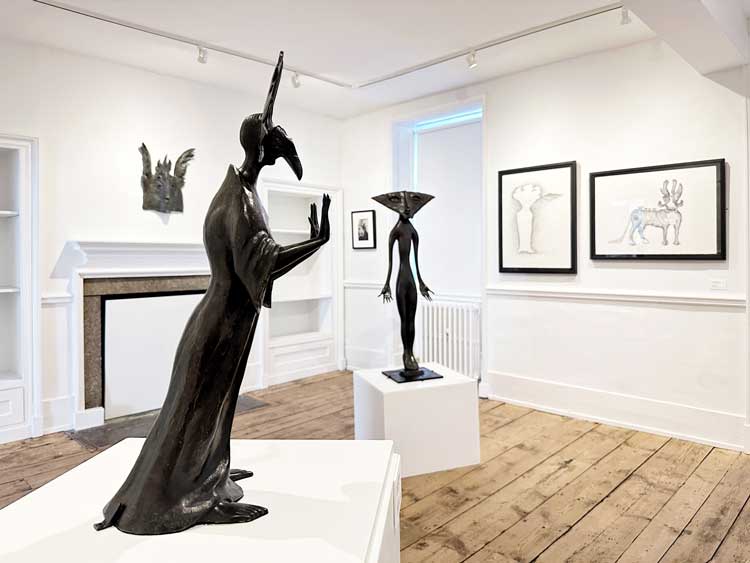
Leonora Carrington: Rebel Visionary, installation view, Newlands House Gallery, 12 July – 26 October 2024. Image courtesy Newlands House Gallery.
Carrington lived her life in the other worlds of her surreal dreams. For an exhibition of her work in Mexico City in 1965, she wrote a mock artist’s statement, which she titled Jezzamathatics, or Introduction to the Wonder Process of Painting, and which opened with the following: “In the early part of the 90s I was born under curious circumstances, in a Eneahexagram, Mathematically. The only person present at my birth was our dear and faithful old fox-terrier, Boozy, and an x-ray apparatus for sterilising cows. My mother was away at the time snaring crayfish which then plagued the upper Andes and wrought misery and devastation among the natives.” I think this serves to give a good idea of the marvellous madness of Carrington’s mind.
In fact, she was born Mary Leonora Carrington on 6 April 1917 in Lancashire, England. Her father had made his fortune in the textiles industry and became principal shareholder in Imperial Chemicals (ICI). She grew up in the rather imposing Crookhey Hall, with every expectation that she should become the perfect debutante. But Carrington had other ideas. For starters, she was set on becoming an artist. After spending time at Mrs Penrose’s Academy of Art in Florence, she enrolled in the new London art school founded by the French modernist Amédée Ozenfant. The first seismic event in her story was, however, her meeting with the German surrealist artist Max Ernst at a dinner party when she was 20 and he was 46. The first couple of rooms in the exhibition introduce us to the Carrington of this era, who very soon found herself befriended by the likes of Lee Miller, Marcel Duchamp and André Breton. There are photographs taken by Miller of a youthful and naive Carrington, beaming up at the camera, and others of her on holiday in Cornwall with a coterie of surrealist artists, during what she later described as “one the happiest times of my life”. In fact, Carrington and Ernst had gone to Cornwall to escape her father’s complaints to the police that Ernst’s work was pornographic. (It wasn’t, but Carrington Sr was not in the slightest convinced regarding Ernst’s intentions with his daughter.) The attempt to claw her back from this life of depravity and certain poverty backfired, however, with Leonora telling her father exactly what she thought and eloping with Ernst to Paris. Equally reactive, her father cut her off, and they never saw one another again.

Leonora Carrington. Untitled Mask, no date. 24K gold plated silver, 22 x 22 x 4 cm. Courtesy of the Leonora Carrington Council and rossogranada.
In prewar Paris, Carrington and Ernst developed their individual practices, each influencing the other. Both had animal familiars or alter egos: Carrington frequently depicted herself as a white horse, while Ernst’s second self was a strange bird called Loplop. From Paris, the couple moved south to the village of Saint-Martin-d’Ardèche, where they transformed their cottage with murals, reliefs and sculptures. Carrington began populating her internal other worlds with characters inspired by folklore and the myths and fairytales with which she had grown up. She relished the Brothers Grimm, but, additionally, her mother, her grandmother and her Irish nanny had told her Celtic folk tales from an early age. Carrington later said: “The stories my grandmother told me were fixed in my mind and they gave me mental pictures that I would later sketch on paper.” In many cases, it is difficult to establish whether her writings preceded her pictorial work, or vice versa, but sometimes reality can be more surreal and unbelievable than imagination, or, as she put it: “Truth is what is strange, what is wonderful.”
When the Nazis came to France, Ernst – a Jew as well as a “degenerate” artist – was a hostile alien. He was captured and imprisoned twice. During his second incarceration, Carrington packed up and crossed the border to Spain, believing she had more chance of effecting his rescue from there. Instead, following a breakdown, she found herself imprisoned, and subject to horrific treatment, in an asylum in Santander. In her memoir, Down Below, published in a surrealist journal in 1944 and in book form decades later, she describes how the strange workings of her grief-stricken mind caused her to be diagnosed as insane. Her matter-of-fact and candid relaying of her disordered thought processes makes one question the liminality of psychosis and delusion. Additionally, she was subjected to barbaric shock therapy. The one glimmer was a special dispensation to receive art materials and spend time drawing. I wouldn’t be surprised were some of the undated sketches included in this exhibition from that strangely productive period.

Leonora Carrington. Beast on Oatmeal Background, 1956. Tapestry, 160 x 100 cm. Private Collection. Installation view, Newlands House Gallery, 12 July – 26 October 2024. Image courtesy Newlands House Gallery.
What came next is even more unimaginable. Her father decided to have Carrington transferred to a sanatorium in South Africa, but, en route to Lisbon, from where she was to set sail for Cape Town, she made a remarkable escape. Carrington told her chaperone – the nurse from the clinic – that she urgently needed the toilet, nipped into a cafe, ran out of the back exit, hopped into a taxi and asked to be taken to the Mexican embassy. Here, she was lucky enough to know a trustworthy diplomat, Renato Leduc. Not only did he enable this immediate escape, but he and Carrington went on to enter into a marriage of convenience, so that she would be provided with the immunity and protection of a diplomat’s wife. Together, they set sail for New York, and from there they went on to Mexico. Carrington fell in love with the country, but not Leduc, and they soon separated. Not too long afterwards, she met and married the Hungarian émigré photographer Emerico “Chiki” Weisz, with whom she had two sons and shared her life until his death in 2007.

Leonora Carrington. Dragon, 1979. Wool tapestry, 197 x 260 cm. Courtesy of the Leonora Carrington Council and rossogranada.
Carrington became fascinated by Mexican history, traditions and folklore, and, in turn, she was accepted by her new country, which, as she grew successful, adopted her as a Mexican artist. In the 1950s, a family of serape weavers of Aztec heritage came to live in Carrington’s house, and they worked together to create a number of tapestries, three of which are included here. Carrington would sketch the designs, and the weavers transferred them on to the loom. They typically depict beasts found elsewhere in her paintings, set against plain backgrounds, rather like grand portraits. One, Dragon (1979), made when she was in her 60s, is paired here with the sculpture Dragoness (2010), made in her 90s, and an untitled oil painting, depicting a blue-winged beast, dating from her teenage years.
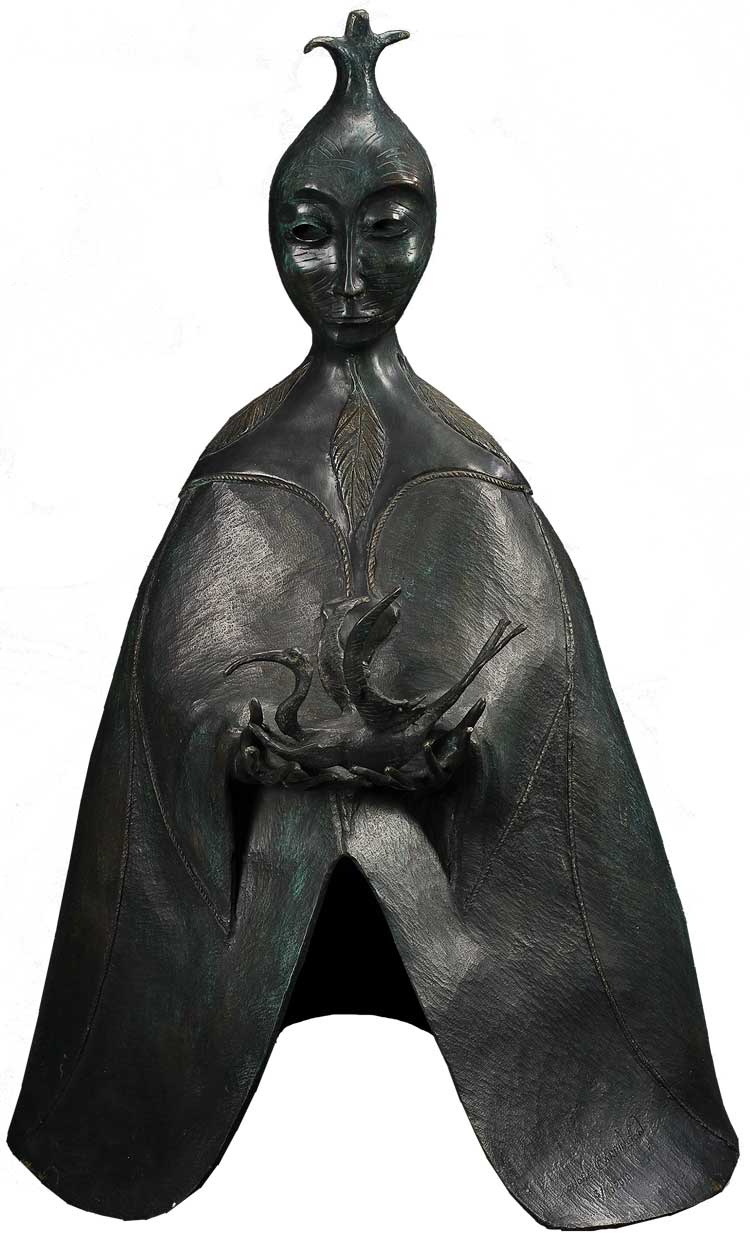
Leonora Carrington. Dragoness, 2010. Bronze sculpture, 76 x 47 x 47 cm. Courtesy of the Leonora Carrington Council and rossogranada.
Carrington also became involved with the world of theatre, writing plays, designing stage sets and costumes, and making masks. The mainstay of this exhibition is the latter, and they embody the ambiguity of shapeshifting, so integral to so much more of Carrington’s oeuvre. The largest room in the exhibition has plinths at its centre on which there is a series of three papier-mache masks made for a 1959 production of The Tempest, and, downstairs, offset by a glorious yellow wall, there is a vast number of bronze masks (labelled as sculptures), which are the building blocks of so many of her recurring characters. The short story, The Debutante (1935), which is an only slightly twisted version of Carrington’s own presentation at the court of King George V, pivots, for example, on a mask-wearing hyena, who attends the ball in the human protagonist’s place, the mask having been obtained by tearing the face off the maid. Empathising with this criminal animal heroine, Carrington, once again speaking zoomorphically, has claimed: “I’m like a hyena, I get into the garbage cans. I have an insatiable curiosity.” Many of her fantastical beasts in her prints and sketches here could be at least part hyena. Who can be sure in this world of visual trickery and deceit?
Carrington not only rejected her middle-class upbringing with its finishing post of the debutantes’ ball, but, despite stating she would never label herself anything with “-ist” at the end, she would almost certainly have made an exception for the term “feminist”. In 1971, she travelled to New York City and met with the feminist writers Gloria Orenstein and Betty Friedan; then, back in Mexico, she became involved with the nascent Women’s Liberation movement. A year later, she designed a poster entitled Mujeres Conciencia (Women’s Awareness), presenting an alternative version of the story of Adam and Eve, featuring two women – one black, one white – exchanging apples as symbols of wisdom. The original poster is on display here in a fabulous small room dedicated to the cause. An untitled sketch from 1933, shown alongside, could be a very early version of the composition, again showing how Carrington’s ideas morph and reform throughout her career and cross-media. Her political commitment led to her winning the Lifetime Achievement Award at the Women’s Caucus for Art in 1986. A quote pasted on the wall captures her vigour: “Most of us, I hope, are now aware that a woman should not have to demand Rights. The Rights were there from the beginning; they must be Taken Back Again.” An audio recording, playing on a loop, relates some of Carrington’s memories of being a woman amid the surrealists in Paris, regretting her missed opportunity to say to them what she with hindsight feels she ought to have, namely: “Bullshit!” However, she did stand up for herself enough to respond to Joan Miró, when he gave her money to go and buy him some cigarettes, by giving it right back and saying that if he wanted cigarettes: “He could bloody well get them himself.”
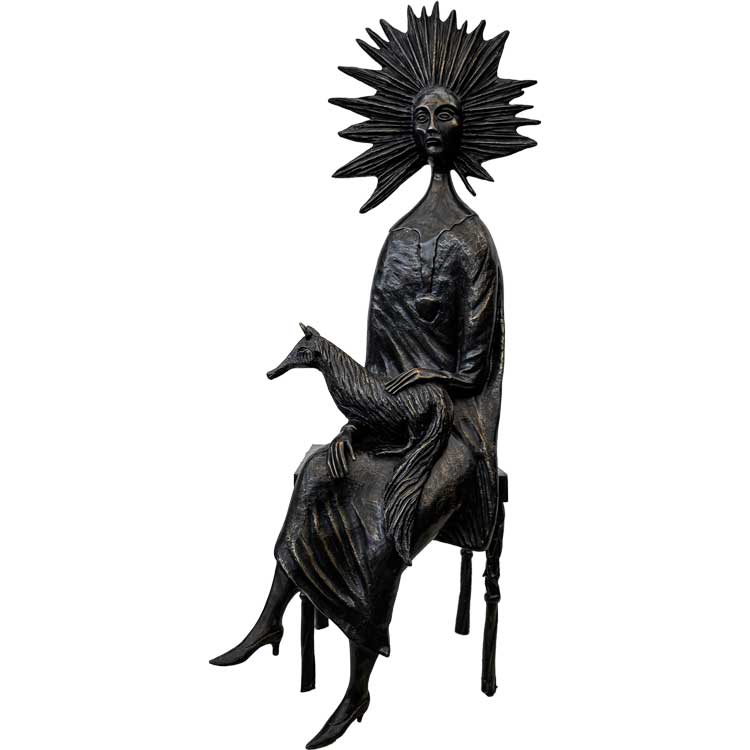
Leonora Carrington. Woman with Fox, 2010. Bronze sculpture, 92 x 34 x 32 cm. Courtesy of the Leonora Carrington Council and rossogranada.
Carrington believed that women could gain power and influence by rediscovering their female ancestry. “What is education after all?” she asked. “Education comes from life.” And this from the woman who had been expelled from two convent schools for unwillingness to collaborate. “They wanted me to conform to a life of horses and hunt balls and to be well considered by the local gentry, I suppose,” she reflects. Carrington remained a rebel in her old age, and, in her 50s, she wrote a novella, The Hearing Trumpet (1974), with an anarchistic, hard-of-hearing, nonagenarian protagonist, Marian Leatherby, who could have been speaking about Carrington’s whole approach to, and experience of, life when she said: “Sleeping and waking are not quite as distinctive as they used to be. I often mix them up.” In another episode, Marian observes: “Holding the mirror at arm’s length, I seemed to see a three-faced female whose eyes winked alternatively. One of the faces was black, one red, one white, and they belonged to the Abbess, the Queen Bee, and myself.” This text is paired, in the exhibition, with two watercolour sketches: The Three Magdalenes (1988), in which the shadowy women indeed have three differently coloured faces, and the larger and more colourful Play Shadow (1977), where three visages appear to constitute one whole personage.
There are a good number of colour lithographs on show, too, representing some of Carrington’s key paintings. It is a shame that there aren’t more of the “real thing”, but, as Moorhead makes clear from the start, this was never the goal. As someone with knowledge of Carrington’s work, who has also read her stories, this curatorial approach brought together some of the most familiar characters, showing their appearances and reappearances, while for someone with less or little prior knowledge, it would, I imagine, serve as a tantalising introduction to Carrington’s parallel worlds. Personajes Fantásticos (lithograph 2011, based on painting 1950), in particular, brings together horses of different colours, hyena-like creatures, a white stag (generally a symbol of purity and beauty and sometimes of change) and hooded figures, some with bird-like beaks, all traversing an icy landscape, with snow-capped volcanic mountains in the distance.
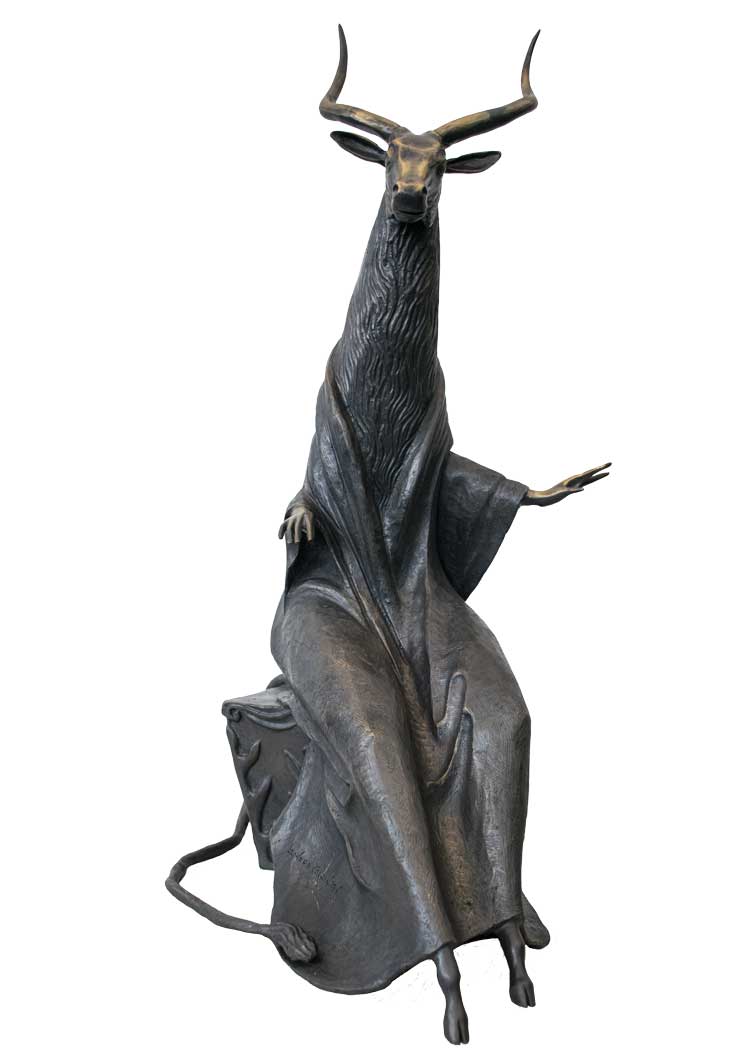
Leonora Carrington. Daughter of the Minotaur, 2010. Bronze sculpture, 82 x 38 x 55 cm. Courtesy of the Leonora Carrington Council and rossogranada.
Another key work, represented here as a lithograph, is And Then We Saw the Daughter of the Minotaur (lithograph 2011, based on painting 1953), which incorporates a portrait of Carrington’s two sons, Gabriel and Pablo. The subject makes reference to the Cretan myth, and its protagonist appears also as a bronze sculpture, Daughter of the Minotaur (2010) – a wonderful example of a piece made in the final year of Carrington’s life, when she could no longer paint.
It is fitting that Carrington’s works are displayed in this old house, with its creaky floorboards and hidden stairways. There are plenty of cupboards and shelves set into the walls, all of which have been left empty. These made me think of some of the surreal photography of Claude Cahun and, later, Francesca Woodman, who contorted themselves into such alcoves, as well as the work of Cathie Pilkington, especially when she had her exhibition at Pallant House Gallery, a similar building to this, and used its many recesses for her blankets and uncanny domestic sculptures. While Carrington’s work is similarly domestic and creepily other worldly at the same time, the isolating of her characters on individual plinths serves well to venerate them as protagonists, drawn from a chaotic mind (and story), but each perfectly formed in Carrington’s imagination. Furthermore, these characters – like Carrington herself – are shown to have broken free of their physical confines. (I concede, however, that the artist was probably correct when she rhetorically stated: “Do you think anyone escapes their childhood? I don’t think we do.”)

Leonora Carrington. Bird, 2011. Bronze sculpture, 69 x 72 x 92 cm. Courtesy of the Leonora Carrington Council and rossogranada.
As noted above, Carrington worked to the very end of her life, as the many lithographs and sculptures on show dated 2010 and 2011 evidence, and Ave, or Bird (2011), was one of her final pieces, drawn and modelled in plasticine in early 2011, before she died that May. As her long-time friend and patron Edward James said: “She never relinquished her love of experimentation; the result being that she was able to diversity and explore a hundred or more techniques for the expression of her creative powers.” Carrington also carried on knowing her own mind to the bitter end. An interview between the artist and Moorhead, playing on a loop, absolutely captures her candid and cantankerous character. Moorhead asks leading questions, with the obvious expectation that Carrington will agree, but the grande dame repeatedly shuts her down with a sharp and scolding “No!”, rebuffing her for trying “to turn the visual world into a kind of intellectual game”. As Marian says, in an internal conversation, early on in The Hearing Trumpet: “Darling stop being philosophical, it doesn't suit you, it makes your nose red.”
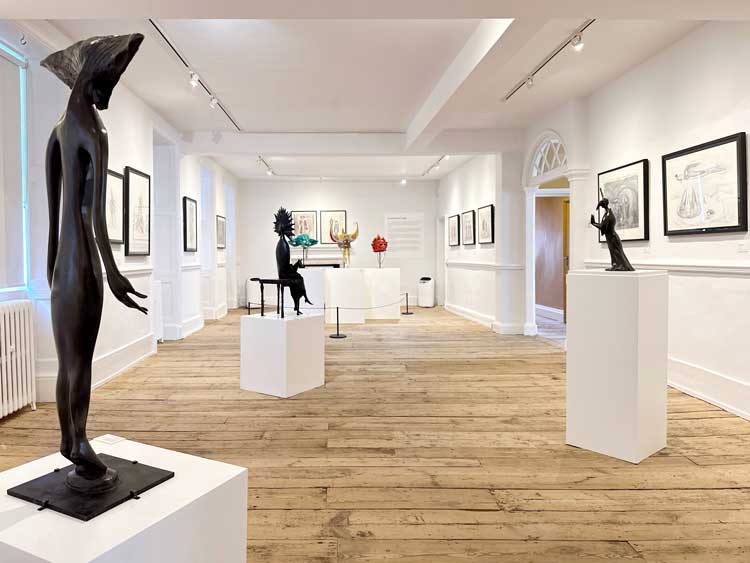
Leonora Carrington: Rebel Visionary, installation view, Newlands House Gallery, 12 July – 26 October 2024. Image courtesy Newlands House Gallery.
A downstairs activity room, possibly intended for children, concludes the exhibition, providing a good space to sit, digest, and ponder the question posed: What would you include in your surrealist survival kit? As I mentally begin to list my items – which include a worry doll I have had since my teenage years; a small ladybird on a stone, which I inherited from my grandmother; my grandfather’s miniature rosary beads in a tiny tin Bible; one of a pair of china mice my nanny kept on her mantelpiece; a piece of sodalite and a unicorn plaster – I can’t help but wonder what fascinating objects would find their way into Carrington’s kit. She is quoted as describing their purpose as: “To offset the destructive acts of daily life, to pull us through the hardest times, to reawaken our sense of wonder and to renew our capacity for reverie and revolt.” One thing is for sure, Carrington’s kit would be neither mundane nor predictable, and there would be a good dose of magic and a sprinkling of alchemy, just as there is in her art. In a way, this exhibition, with its masks, figurines and sketches, serves as just that.
As I exit through the gift shop, there is a parting quote from Carrington cited on the wall: “Once a dog barked at a mask I made. That was the most honourable comment I received.” Well, Leonora, Parsley (my support dog) barked at your sculptures as well. And his is a judgment I venerate.